In this blog, we will teach you how to diagnose and treat Aphthous Stomatitis and its’ three main subtypes: minor, major, and herpetiform aphthae.
Don’t have time to read this article? We get it. Download the Diagnosing Vesicular Ulcerative Conditions checklist to get the key information and images from this article plus all the other conditions we cover in the Dentist’s Guide to Oral Pathology.
If you see these lesions frequently and very severely you need to consider Behçet’s Disease, a nutritional deficiency, and Crohn’s disease.
In general, an aphthous ulcer is very common; 20% of the population is affected. There’s no age, gender, or race predilection, but there is a familial tendency based on human leukocyte antigen (HLA) types.
We don’t know exactly the triggers in each patient but we do know that it is an autoimmune condition. It’s not something that can be transmitted to others. It is not infectious. It relates to the stimulation of T-lymphocytes that enter and damage the mucosal epithelium.
Aphthous Stomatitis Ulcer Causes
The stimulating factors are different things in different people. There’s been a lot of different precipitating factors ranging from stress and trauma to strawberries and toothpaste with sodium laurilsulfate (SLS). Even stopping smoking can cause lesions to occur.
Remember, you only see aphthous stomatitis on moveable mucosa. That’s how you differentiate aphtae from herpes in an immunocompetent patient. Herpes is found on attached mucosa. Aphthous is found on moveable mucosa.
Aphthous Stomatitis is not going to be precipitated by a vesicle. It doesn’t have a vesicular stage. Once the ulcer has appeared, the active disease is over and the treatment of the ulceration should be directed at pain relief.
Because ulcers are not preceded by vesicles or bullae, clinically you can see the minor form which is one or two small alterations.
How to Diagnose Minor Aphthous Stomatitis
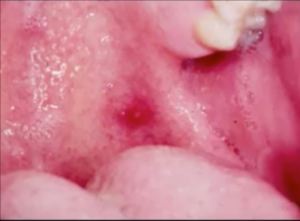
In figure 1 we see an ulcer, with an erythematous halo surrounding the ulceration. These will heal. Oftentimes they’re very painful and is out of proportion with what you’re seeing clinically. That’s suggestive of minor aphthous stomatitis.
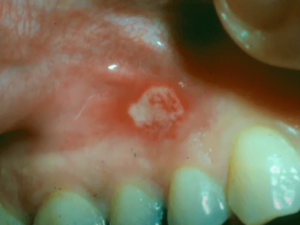
In figure 2 we observe an example of a larger lesion with the same kind of ulceration with an erythematous halo on unmovable mucosa. It is curious that it is kind of the height of the vestibule.

Above we see some lesions of the tongue and the mandibular buccal fold. Remember you only see aphthous stomatitis, white ulcerations with erythematous halo on moveable mucosa.
Minor Aphthae Clinical Features
- Size: <0.5 cm
- Shape: Oval
- Number:1-5
- On Non-keratinized mucosa
Minor Aphthae Treatment
- Topical corticosteroids
- Tetracycline mouth rinse
How to Diagnose Major Aphthous Stomatitis
Sometimes patients are unlucky enough that they have major aphthous stomatitis. This can look really scary. It is very painful, and the lesions will resolve within a couple weeks.
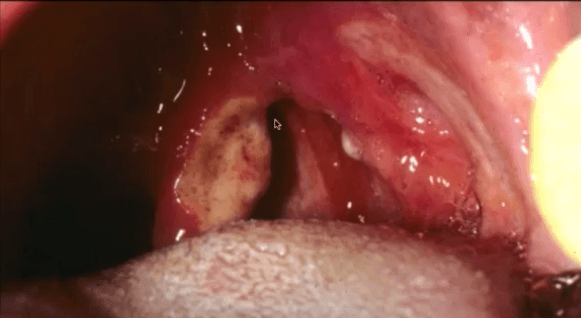
Patients may or may not have a couple episodes of major aphthous stomatitis a year.
Below are two examples of major aphthae ulcers. We’re seeing vesicles with a erythematous halo surrounding the lesions.
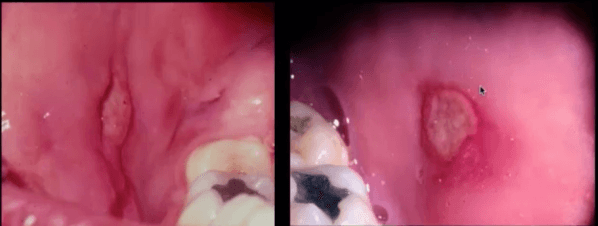
Major Aphthae Clinical Features
- Size: > 0.5 cm
- Shape: Ragged, Oval
- Number:1-10
- On Non-keratinized mucosa
Major Aphthae Treatment
- Topical, systemic, intralesional corticosteroids
- Immunosuppressives.
How to Diagnose Aphthous Ulcers
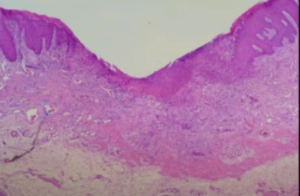
For apthous ulcers, the diagnosis is a clinical diagnosis. If you do take a biopsy of an aphthous ulcer you won’t get a report, because it’s nonspecific.
What we’re seeing here is epithelium with a hyperkeratotic surface. This is the ulceration in the center and it’s nonspecific; nondescript of an aphthous ulcer.
Herpetiform Aphthae Clinical Features
Herpetiform aphthae look like herpes but with ulcerations.
- Size: <0.5 cm
- Shape: Oval
- Number: 10 – 100
- On any intraoral surface
Herpetiform Aphthae Treatment
- Topical, systemic corticosteroids
- Tetracycline mouth rinse
Vesicular Ulcerative Conditions
Download the Diagnosing Vesicular Ulcerative Conditions checklist to get all the key information and images from this article.

Postgraduate Oral Pathology and Radiology Certificate
Learn more about the clinical and didactic skills necessary to evaluate and manage patients with oral diseases by enrolling in Herman Ostrow School of USC’s online, competency-based certificate program in Oral Pathology and Radiology.

